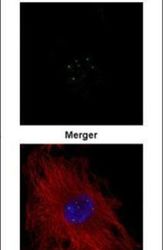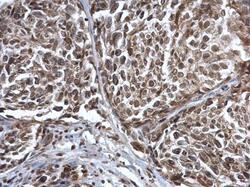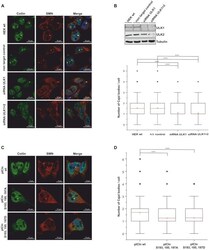Antibody data
- Antibody Data
- Antigen structure
- References [1]
- Comments [0]
- Validations
- Immunocytochemistry [1]
- Immunohistochemistry [1]
- Other assay [1]
Submit
Validation data
Reference
Comment
Report error
- Product number
- PA5-29531 - Provider product page

- Provider
- Invitrogen Antibodies
- Product name
- Coilin Polyclonal Antibody
- Antibody type
- Polyclonal
- Antigen
- Recombinant full-length protein
- Description
- Recommended positive controls: HepG2 , HepG2 nuclear extract, 293T nuclear extract. Predicted reactivity: Rhesus Monkey (95%). Store product as a concentrated solution. Centrifuge briefly prior to opening the vial.
- Reactivity
- Human
- Host
- Rabbit
- Isotype
- IgG
- Vial size
- 100 μL
- Concentration
- 0.66 mg/mL
- Storage
- Store at 4°C short term. For long term storage, store at -20°C, avoiding freeze/thaw cycles.
Submitted references An essential role of the autophagy activating kinase ULK1 in snRNP biogenesis.
Schmitz K, Cox J, Esser LM, Voss M, Sander K, Löffler A, Hillebrand F, Erkelenz S, Schaal H, Kähne T, Klinker S, Zhang T, Nagel-Steger L, Willbold D, Seggewiß S, Schlütermann D, Stork B, Grimmler M, Wesselborg S, Peter C
Nucleic acids research 2021 Jun 21;49(11):6437-6455
Nucleic acids research 2021 Jun 21;49(11):6437-6455
No comments: Submit comment
Supportive validation
- Submitted by
- Invitrogen Antibodies (provider)
- Main image

- Experimental details
- Immunofluorescent analysis of Coilin in methanol-fixed HeLa cells using a Coilin polyclonal antibody (Product # PA5-29531) (Green) at a 1:500 dilution. Alpha-tubulin filaments were labeled with Product # PA5-29281 (Red) at a 1:500.
Supportive validation
- Submitted by
- Invitrogen Antibodies (provider)
- Main image

- Experimental details
- Immunohistochemistry (Paraffin) analysis of Coilin was performed in paraffin-embedded human cervical cancer tissue using Coilin Polyclonal Antibody (Product # PA5-29531) at a dilution of 1:500.
Supportive validation
- Submitted by
- Invitrogen Antibodies (provider)
- Main image

- Experimental details
- Figure 6. Decrease of endogenous ULK1 results in a decreased number of Cajal bodies. ( A , B ) HEK293T cells were treated with 50 nM ULK1,2 siRNA or non-targeting control for 48 h. ( A , C ) The cells were fixed and Cajal bodies were visualized with antibody staining against Coilin (green) and SMN (red). The DNA was stained with DAPI (blue). ( B ) Cell lysates of siRNA-treated cells were analyzed by Tris/Glycine-SDS-PAGE using antibodies against ULK1, ULK2, and Tubulin. The downregulation of ULK1 causes a reduction in the snRNP storage pool. In the boxplot diagram, the 'box' represents 25-75% of all values and the mean (red), standard deviation, and out layers are visualized. HEK293T cells show an average of 1.54 (n = 500) Cajal bodies. Treatment of cells with siRNA caused a 1. significant decrease in the number of Cajal bodies. ( C , D ) The phosphorylation status of pICln influences the number of Cajal bodies per cell. ( D ) Overexpression of pICln in Flp-In T-Rex cells causes an increase in the number of Cajal bodies, mean 1.69 (n = 502). Phosphomutants of pICln (S193, 195, 197A, or D), cause a decrease in the number of Cajal bodies per cell. The P -value was calculated with Origin using the Mann-Whitney U test. *** P < 0.005; scale bars: 10 mum (A and C).
 Explore
Explore Validate
Validate Learn
Learn Western blot
Western blot Immunocytochemistry
Immunocytochemistry